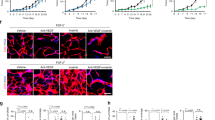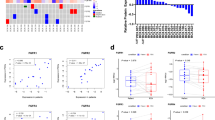Abstract
FGFR1 amplification has been found in 15% of patients with breast cancer and has been postulated as a promising marker to predict response against FGFR inhibitors. However, early phase clinical trials of selective FGFR inhibitors demonstrated only limited efficacy in FGFR1-amplified breast cancer patients. We found that BGJ398, an FGFR inhibitor, effectively inhibited phosphorylation of FGFR1 and MEK/ERK signaling in FGFR1-amplified breast cancer without affecting tumor cell proliferation. However, FGFR1 knockout inhibited tumor angiogenesis in vivo. We unraveled that FGFR1 regulates the secretion of the proangiogenic vascular endothelial growth factor (VEGF) in a MAPK-dependent manner. We further found that FGF-FGFR1 signaling induces an autocrine activation of VEGF-VEGFR1 pathway that again amplifies VEGF secretion via VEGF-VEGFR1-AKT signaling. Targeting both VEGFR1 and FGFR1 resulted in synergistic anti-angiogenic treatment effects in vivo. We thus postulate synergistic treatment effects in FGFR1/VEGFR1-positive breast cancer patients by dual targeting of FGFR and VEGFR.
This is a preview of subscription content, access via your institution
Access options
Subscribe to this journal
Receive 50 print issues and online access
$259.00 per year
only $5.18 per issue
Buy this article
- Purchase on Springer Link
- Instant access to full article PDF
Prices may be subject to local taxes which are calculated during checkout





Similar content being viewed by others
References
Malchers F, Dietlein F, Schöttle J, Lu X, Nogova L, Albus K, et al. Cell-autonomous and non-cell-autonomous mechanisms of transformation by amplified FGFR1 in lung cancer. Cancer Discov. 2014;4:246-57.
Weiss J, Sos ML, Seidel D, Peifer M, Zander T, Heuckmann JM, et al. Frequent and focal FGFR1 amplification associates with therapeutically tractable FGFR1 dependency in squamous-cell lung cancer. Sci Transl Med. 2010;2:62ra93
Helsten T, Elkin S, Arthur E, Tomson BN, Carter J, Kurzrock R. The FGFR landscape in cancer: analysis of 4,853 tumors by next-generation sequencing. Clin Cancer Res. 2016;22:259–67.
Turner N, Pearson A, Sharpe R, Lambros M, Geyer F, Lopez-Garcia MA FGFR1 amplification drives endocrine therapy resistance and is a therapeutic target in breast cancer. Cancer Res. 2010;70:2085-94.
Ocana A, Pandiella A. Targeting oncogenic vulnerabilities in triple negative breast cancer: biological bases and ongoing clinical studies. Oncotarget. 2017;8:22218-22234.
The Cancer Genome Atlas N. Comprehensive molecular portraits of human breast tumors. Nature. 2012;490:61–70.
André F, Cortes J. Rationale for targeting fibroblast growth factor receptor signaling in breast cancer. Breast Cancer Res Treat. 2015;150:1-8.
André F, Daly F, Azim H, Agrapart V, Fumagalli D, Gingras I, et al. Abstract OT1-03-03: FINESSE—an open, 3-cohort, phase II trial testing oral administration of lucitanib in patients with FGFR1-amplified or non-amplIfied estrogen receptor positive metastatic breast cancer. Journal of Clinical Oncology 2014;32(15_suppl):TPS1134.
Musolino A, Campone M, Neven P, Denduluri N, Barrios CH, Cortes J, et al. Phase II, randomized, placebo-controlled study of dovitinib in combination with fulvestrant in postmenopausal patients with HR+, HER2− breast cancer that had progressed during or after prior endocrine therapy. Breast Cancer Res. 2017;19:18.
Goyal L, Saha SK, Liu LY, Siravegna G, Leshchiner I, Ahronian LG, et al. Polyclonal secondary FGFR2 mutations drive acquired resistance to FGFR inhibition in patients with FGFR2 fusion-positive cholangiocarcinoma. Cancer Discov. 2017;7:252–63.
Malchers F, Ercanoglu M, Schutte D, Castiglione R, Tischler V, Michels S, et al. Mechanisms of primary drug resistance in FGFR1-amplified lung cancer. Clin Cancer Res. 2017;23:5527–36.
Datta J, Damodaran S, Parks H, Ocrainiciuc C, Miya J, Yu L, et al. Akt activation mediates acquired resistance to fibroblast growth factor receptor inhibitor BGJ398. Mol Cancer Ther. 2017;16:614–24.
Nogova L, Sequist LV, Garcia JMP, Andre F, Delord J-P, Hidalgo M, et al. Evaluation of BGJ398, a fibroblast growth factor receptor 1-3 kinase inhibitor, in patients with advanced solid tumors harboring genetic alterations in fibroblast growth factor receptors: results of a global phase I, dose-escalation and dose-expansion study. J Clin Oncol. 2017;35:157–65.
Lee T-H, Seng S, Sekine M, Hinton C, Fu Y, Avraham HK, et al. Vascular endothelial growth factor mediates intracrine survival in human breast carcinoma cells through internally expressed VEGFR1/FLT1. PLoS Med. 2007;4:e186.
Wu Y, Hooper AT, Zhong Z, Witte L, Bohlen P, Rafii S, et al. The vascular endothelial growth factor receptor (VEGFR-1) supports growth and survival of human breast carcinoma. Int J Cancer. 2006;119:1519–29.
Chatterjee S, Heukamp LC, Siobal M, Schottle J, Wieczorek C, Peifer M, et al. Tumor VEGF:VEGFR2 autocrine feed-forward loop triggers angiogenesis in lung cancer. J Clin Invest. 2013;123:1732–40.
Dales JP, Garcia S, Bonnier P, Duffaud F, Carpentier S, Djemli A, et al. Prognostic significance of VEGF receptors, VEGFR-1 (Flt-1) and VEGFR-2 (KDR/Flk-1) in breast carcinoma. Ann Pathol. 2003;23:297–305.
Mylona E, Alexandrou P, Giannopoulou I, Liapis G, Sofia M, Keramopoulos A, et al. The prognostic value of vascular endothelial growth factors (VEGFs)-A and -B and their receptor, VEGFR-1, in invasive breast carcinoma. Gynecol Oncol. 2007;104:557–63.
Lu KV, Chang JP, Parachoniak CA, Pandika MM, Aghi MK, Meyronet D, et al. VEGF inhibits tumor cell invasion and mesenchymal transition through a MET/VEGFR2 complex. Cancer Cell. 2012;22:21–35.
Kopetz S, Hoff PM, Morris JS, Wolff RA, Eng C, Glover KY, et al. Phase II trial of infusional fluorouracil, irinotecan, and bevacizumab for metastatic colorectal cancer: efficacy and circulating angiogenic biomarkers associated with therapeutic resistance. J Clin Oncol. 2010;28:453–9.
Packer L, Geng X, Bonazzi VF, Ju R, Mahon C, Cummings MC, et al. PI3K inhibitors synergize with FGFR inhibitors to enhance antitumor responses in FGFR2-mutant endometrial cancers. Mol Cancer Ther. 2017;16:637-48.
Terry S, El-Sayed IY, Destouches D, Maille P, Nicolaiew N, Ploussard G, et al. CRIPTO overexpression promotes mesenchymal differentiation in prostate carcinoma cells through parallel regulation of AKT and FGFR activities. Oncotarget. 2015;6:11994–2008.
Herrera-Abreu MT,Pearson A,Campbell J,Shnyder SD,Knowles MA,Ashworth A, et al. Parallel RNA interference screens identify EGFR activation as an escape mechanism in FGFR3-mutant cancer. Cancer Discov. 2013;3:1058–71.
Kut C,Mac Gabhann F,Popel AS, Where is VEGF in the body? A meta-analysis of VEGF distribution in cancer. Br J Cancer. 2007;97:978–85.
Stewart SA, Dykxhoorn DM, Palliser D, Mizuno H, Yu EY, AnDS, et al. Lentivirus-delivered stable gene silencing by RNAi in primary cells. RNA. 2003;9:493–501.
Acknowledgements
This work was supported by the Thyssen Foundation (Grant No.: 10.16.1.028MN to RTU), by the Nachwuchsforschungsgruppen-NRW (Grant No.: 1411ng005 to RTU), by the Deutsche Forschungsgemeinschaft (DFG) (Grant No.: UL379/1-1 to RTU) and by the Deutsche Krebshilfe (Grant No.: 70113009 to RTU).
Author information
Authors and Affiliations
Corresponding author
Ethics declarations
Conflict of interest
RTU received consulting fees from Novartis. FM received consulting fees from NEO NewOncology GmbH. VR-O is now a Novartis employee. The remaining authors declare that they have no conflict of interest.
Electronic supplementary material
Rights and permissions
About this article
Cite this article
Golfmann, K., Meder, L., Koker, M. et al. Synergistic anti-angiogenic treatment effects by dual FGFR1 and VEGFR1 inhibition in FGFR1-amplified breast cancer. Oncogene 37, 5682–5693 (2018). https://doi.org/10.1038/s41388-018-0380-3
Received:
Revised:
Accepted:
Published:
Issue Date:
DOI: https://doi.org/10.1038/s41388-018-0380-3
This article is cited by
-
Modelling the complex nature of the tumor microenvironment: 3D tumor spheroids as an evolving tool
Journal of Biomedical Science (2024)
-
Impact of fibroblast growth factor receptor 1 (FGFR1) amplification on the prognosis of breast cancer patients
Breast Cancer Research and Treatment (2020)



